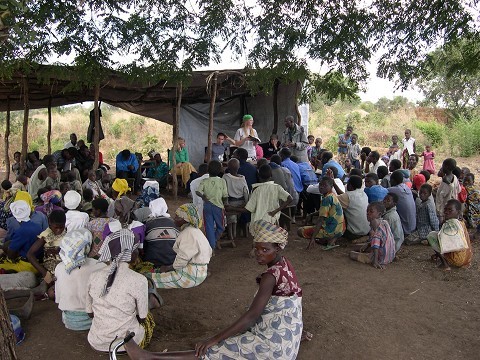Short-term missions trips continue to boom

 When I first started going on short-term mission trips in 1975, I was an oddball. No one knew what to make of a high school student going off to Guatemala for two months. But these days, short-term missions are standard fare for young people eager to do good while seeing the world.
When I first started going on short-term mission trips in 1975, I was an oddball. No one knew what to make of a high school student going off to Guatemala for two months. But these days, short-term missions are standard fare for young people eager to do good while seeing the world.
Washington Post Staff Writer
Saturday, July 5, 2008;
Despite the concerns with trips abroad, their popularity is soaring.
Some groups go as far away as China, Thailand and Russia. From a few
hundred in the 1960s, the trips have proliferated in recent years. A Princeton University
study found that 1.6 million people took short-term mission trips — an
average of eight days — in 2005. Estimates of the money spent on these
trips is upward of $2.4 billion a year. Vacation destinations are
especially popular: Recent research has found that the Bahamas receives
one short-term missionary for every 15 residents.
At the same time, the number of long-term American missionaries, who
go abroad from several years to a lifetime, has fallen, according to a
Wheaton College study done last year.The short-term mission trip is a “huge phenomenon that seems to be
gaining in momentum rather than waning,” said David Livermore,
executive director of the Global Learning Center at Grand Rapids
Theological Seminary, who studies the trend.Participants care for orphans, hold Bible classes, evangelize, paint
homes and churches, and help AIDS patients, among other tasks.But research has found that the trips tend to have few long-term
effects on the local people or on the mission travelers. Some projects
take away work from local people, are unnecessary and sometimes
dangerous.“I really don’t think that most people are trying to be ugly
Americans,” said Glenn Schwartz, executive director of World Mission
Associates and author of “When Charity Destroys Dignity.” “But they’re
misinformed and don’t realize how their good intentions can go awry.”Mission groups also often bring their own experts and ignore local authorities on the ground.
In Monrovia, Liberia, three years ago, tragedy occurred when
visitors built a school to their standards instead of Liberian
standards. During the monsoon season, the building collapsed, killing
two children, Livermore said.Critics also question the expense involved in sending people long
distances. Short-term missionaries pay $1,000 each, or far more, in
plane fare and other expenses to get to remote destinations.A 2006 study in Honduras found that short-term mission groups spent
an average of $30,000 on their trips to build one home that a local
group could construct for $2,000.“To spend $30,000 to paint a church or build a house that costs
$2,000 doesn’t make a whole lot of sense,” said Kurt Ver Beek, a
professor of sociology at Calvin College who conducted the research.A coalition that organizes mission trips has also set up standards
that call for consultations with local organizations during planning,
cultural training for participants and qualified leaders to be sent
with the group.“If [the trips] are only about ourselves, then we’re doing nothing
more than using another culture . . . to get some benefit at their
expense,” said the Rev. Roger Peterson, chairman of the Alliance for
Excellence in Short-Term Mission, who helped set up the standards. “I
don’t care what verse of the Bible you read, it’s wrong, it’s wrong,
it’s wrong.”

That short term feel good experience for the church sometimes cost those we are serving so much more. I have seen it time and time again and it is nice to see that the church is looking and reflecting on the use of short term missions trips and looking at ways to improve the outcome for those that we are serving! As the church we need to spend the money and time to pray for the long term missionaries. Keep them covered in prayer and support them so they may stay in place were they are at. This will have the biggest impact on the communities we are called to serve.
You know… I read about the money with mixed emotions. Part of me says “could we use that money better?” but more of me says “Wow! We really are willing to spare no expense to reach the lost!” Those of us inside the short-term world know the amazing benefits that happen on a trip. As we sent our team off this morning at the airport one of my girls said “Wow. One month ago I showed up at the Atlanta Airport. Now I’m leaving the airport a completely different person.” Her life was forever changed due to the short term movement. The cost, though high, is totally worth it and those dollar amounts seem to reflect that people know that.
Four years ago our daughter was heading out for her first short-term mission trip to Uganda, Africa. The trip was being led by our best friend who had spent 3 years living in the country decades before. I did the math and asked if the people there would not be better served by the team sending the tens of thousands of dollars that the trip was costing rather than sending an assortment of Americans. His answer was yes, but will people send the money? Will they care if they don’t know? Will they know if they don’t go?
Since that trip, almost every member of the team has felt led to give financially and many have returned personally. Some have sent children to school, others have sent money to build schools. An entire congregation was moved to campaign for mosquito nets, and that, in turn, incited a local business to send nets as well. Real relationships of the heart have formed with brothers and sisters separated by cultures and oceans and currencies, but bound together by a mighty God who adopted us all.
My daughter’s first trip to Africa has led to two more, so far. This last time she brought one of her brothers and me. And now I have the tiny nation of Swaziland burned lovingly in my heart and in my consciousness, no longer a hazy image of a dark foreign land.
Tread carefully. Examine methods and motives. But there is value to short-term missions that go deeper and wider than the eye can easily perceive.
-Debi
After spending all last summer in New Orleans leading missions teams for AIM, I led a team from my church in Delaware to NOLA just two weeks ago. And I am more and more convinced that these short term experienced give people the opportunity to see the heart of Christ in a way that they never could at home.
One day last summer, the front page story in the Times-Picayune (the newspaper of New Orleans) was on the churches that came to serve. Then, when I was there two weeks ago, there were at least 4 separate occasions where people said to me, “If it were for the churches, it would look like the storm had just happened.”
We are now just shy of 3 years out since Katrina. The people of New Orleans know that if it were not for the church coming to serve, they would never recover. We need to be careful and informed when taking these trips, but the heart of God is for hurting people and it’s at the core of our call to go and serve them.
“Christian Tourism” comes to mind. People have mixed reasons for going on short term mission trips, hopefully more focus is on the mission and not the trip.
Whatever the reasons for people going, praise God, because He is good, and can use it for the glory of God!
January 21 , 2010
Dear friends:
My name is Gustavo Poublanc I have been a tour guide specializing in Central America since 1992. In 2007 I have started my own company for the purpose of offering small capacity coaches and buses for hire to the tourism industry.
In my capacity as a tourism industry professional I have noted that mission groups coming to Honduras often need to rent multiple vans or pick up trucks to accommodate their larger groups; resulting in their people having to travel in separately.
I am writing to offer my fleet of buses as an alternative to the renting of multiple vehicles for larger groups seeking transportation.
· Toyota Coasters: 26 passenger capacity
Roof Top Luggage Rack
Air conditioned
· Toyota Mini -Vans: 12 passenger capacity
Air conditioned
These are some of our clients:
Paramedic for Children Rodger Harrison RodgeratPFC@aol.com
Le Mars Francis Seivert fseivert@yahoo.com
Habitat For Humanity Luis Madrid luisen22000@yahoo.com.ar
We offer competitive pricing on your bus rental needs.
I look forward to providing for you transportation needs. We can be contacted through the above noted phone number.
Yours truly,
Gustavo Poublanc[1]
[1]Residencial Paseo Las Fuentes 1era. Etapa Bloque 3 Casa # 18 N. E. San Pedro Sula, Honduras C. A. Tel. 9986-1078 E-Mail gustavo_poublanc@yahoo.com
I struggle sometimes with short-term vs long-term. I’ve always advocated both and still do. Here’s the thing I’ve been thinking about lately: Paul was a short-term guy. He only stayed a few weeks or months and not more than a year and half. I’m just sayin’.